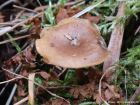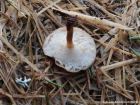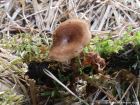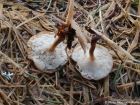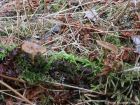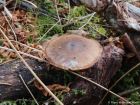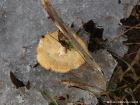Cap greyish brown or cigar brown, sometimes with faint concentric zonation, convex with shallow central depression, smooth, with wavy, often inrolled margin. The flesh is white and leathery. Stem central or slightly off-center, more or less equal in thickness, dry to the touch, and either bald or finely hairy. The color ranges from whitish to grayish or pale brownish, and the texture is tough. Spore print white.
Microscopic Features: Spores are cylindrical or sausage-shaped, smooth, and measure 4 to 7 by 2 to 2.5 micrometers. They are inamyloid, meaning they do not stain in iodine-based reagents.
Similar species: Similar species include Polyporus ciliatus, which typically fruits in spring and early summer, while Polyporus brumalis appears in late autumn and winter.
Synonyms: Lentinus brumalis is a synonym of Polyporus brumalis.
Polyporus brumalis on the www.first-nature.com web site.
Polyporus brumalis on the MushroomExpert.Com Web site.
Many mushrooms are poisonous, and some can be lethally toxic. Distinguishing between edible and poisonous mushrooms can be very challenging. Therefore, we strongly advise against consuming wild mushrooms. This website does not contain any information about the edibility or toxicity of mushrooms.
Although efforts have been made to ensure accuracy on this website, the information may contain errors and omissions. Therefore, all content provided is for educational and informational purposes only and should not be relied upon or used as a basis for consuming any plants or mushrooms.
External links are provided for reference only. We do not endorse or take responsibility for the content, advice, or products found on these sites or in any advertisements shown on this website.
